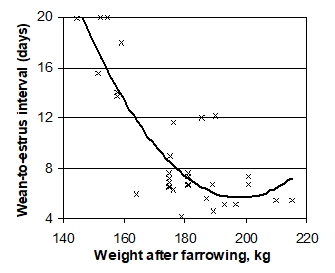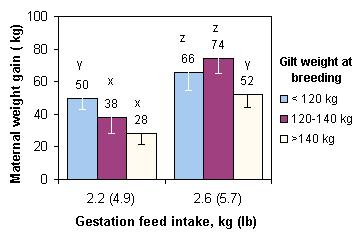| | Bottom line
A key recommendation from the gilt development strategy for the University of Alberta's Swine Research and Technology Centre was to breed gilts at 135 to 150 kg (298 to 331 lb) to reach at least 175 kg (386 lb) after farrowing.
Heavier gilts, is there a benefit?
Sows usually mobilize tissue and lose some weight in lactation. But if too much weight is lost, performance will decline.
Research at the University of Alberta indicated that first-litter sows can lose about 9 per cent of their body protein with little effect on performance. Losses greater than this level result in reduced milk production and reproductive performance (Table 1).
Fewer large follicles on the ovary and lower hormone (estradiol) levels in those follicles at weaning indicated that the ovaries of sows that lost significant amounts of weight were less well prepared for rebreeding. A 9 per cent (~2.9 kg) protein loss in these 196 kg sows (~16mm backfat) was equivalent to at least an 18 kg weight and 1.5 mm backfat loss.
Table 1. First-litter sows can lose up to 9 per cent body protein before production declines

* Measure of follicle maturity; higher levels indicate sow better prepared to be rebred
First-litter sows weighing more than 175 kg after farrowing are better protected against reduced fertility due to large weight losses in lactation. This is because heavier sows (>175 kg) have larger fat and protein tissue reserves to draw upon to support milk production if feed intake is inadequate.
Researchers demonstrated this aspect in a joint experiment with University of Alberta's Swine Research and Technology Centre and the Lacombe Research Station. Heavier first-litter sows (195 vs 165 kg after farrowing) that lost 11 per cent body protein in lactation maintained faster litter growth rates and had a better prepared ovary for rebreeding at weaning, indicating higher potential fertility (Table 2). Factors such as genetics, management, and environment also play a major role.
In general, reproductive responses of first-litter sows that lose large amounts of weight in lactation are often less dramatic in heavier than lighter sows. Wean-to-estrus interval analysis of first-litter sows that lost over 15 kg in lactation, against their weight after farrowing, supports a greater than 175 kg target weight after farrowing (Figure 1).

Figure 1. Lighter first-litter sows that lost more than 15 kg in lactation took longer to return to heat (summary of 11 studies).
Table 2. Heavier first-litter sows performed better after an 11 per cent protein loss

Heavier gilts are not necessarily more fertile than lighter gilts at breeding.
If gilts are heavy at breeding because they do not respond to boar exposure quickly, they may not be retained in the herd long. Gilts that do not respond promptly (within 40 days) to boar exposure, when starting puberty induction at 160 days, have about a 2 in 3 chance of ever being bred. If bred, these gilts might be more likely to be culled early due to fertility problems.
It is important that gilts are bred at their second observed heat, at least (i.e. are more mature), and achieve an appropriate backfat depth (are not too fat or thin) after farrowing.
The decision to produce heavier gilts must not be taken lightly.
If poor appetite and reproductive performance are a problem in a herd, producing a heavier gilt at farrowing (175 kg or more) by breeding at a heavier weight or feeding at a higher level in gestation could be a useful management strategy. However you must consider these factors:
- Larger, heavy gilts become larger sows and likely grow too big for the production system (especially if you have smaller stalls and crates) and are culled out of the herd sooner.
- Heavy gilts are more expensive to feed. Assuming a 50 kg maternal weight gain in gestation and a diet cost of $200 per tonne, it would cost ~$9.20 more in gestation to feed a 150 kg rather than 120 kg gilt at breeding. This is because the heavier gilt is fed more (2.6 vs 2.2 kg per day or 5.7 vs 4.9 lb) in gestation (Figure 2).

Figure 2. Lighter gilts fed the same level gain more maternal weight in gestation.
Gilt breeding weights of <120 kg, 120 to 140 kg, or >140 kg. Gilts fed either 2.2 kg (4.9 lb: range 4.4 to 5.1 lb) or 2.6 kg (5.7 lb: range 5.5 to 6.0 lb) in gestation.
Bottom Line
The benefits and economic cost of breeding heavier gilts must be determined in individual production systems. Factors such as management, gestation stall and farrowing crate size, and whether poor appetite in lactation and subsequent reproductive performance are a problem should be considered.
As protein gain during the first gestation can be manipulated by diet, gilts may be bred lighter and still achieve sufficient body reserves at farrowing to withstand tissue losses during lactation.
For more information contact the Alberta Ag-Info Centre
Telephone: 310-FARM (3276) Out of province: 403-742-7901 |
|